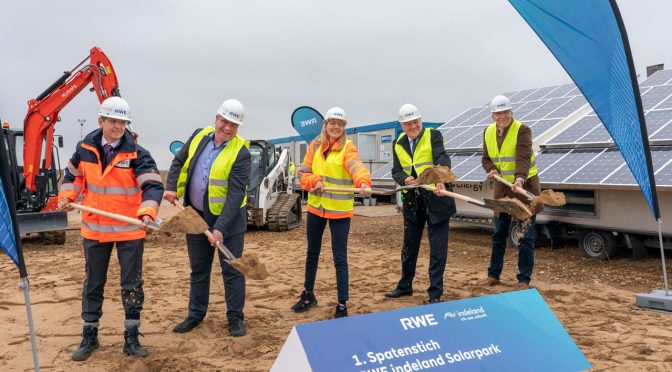In only a few weeks’ time, RWE’s Inden Opencast Mine will no longer produce just lignite, but also solar power. After officially breaking ground, building work has commenced for a utility-scale photovoltaics system with integrated battery storage. The solar modules will produce a peak electric output of 14.4 megawatts (MW). The “RWE indeland Solarpark” is the first of its kind in Europe and combines around 26,500 solar modules and a battery storage system. The plant is expected to be commissioned by late summer this year.
The plant is named after the Inden opencast mining region where it is located, in the district of Düren, North Rhine-Westphalia. Lignite mining will end in seven years and leave an extensive lake – the centre of a dramatically changing landscape. District Administrator Wolfgang Spelthahn, Mayor Stefan Pfennings and indeland Managing Director Jens Bröker all work closely with RWE on shaping the future of this area. Together with RWE Renewables CEO Onshore Wind and Solar Katja Wünschel and RWE Power CTO Dr Lars Kulik, they officially launched the construction work for the plant.
The solar modules will be installed in two 1.4-kilometre-long and 100-metre-wide rows on a gravelled surface at the western edge of the opencast mine. After the end of mining operations in 2029, the area will be at the edge of the lake. However, it will take two decades before water reaches this area – paving the way for the delivery of this innovative large scale solar farm with battery storage. That is exactly what RWE proposed to the German Federal Network Agency as part of a tender for innovation initiatives – and which it won last year.
The battery storage system is designed for a two-hour charging and supply cycle of 9.6 megawatt hours, functioning as a buffer between generation and grid. In this way, feed-in can be even better tailored to meet demand.
Katja Wünschel, CEO Onshore Wind and Solar Europe & Australia at RWE Renewables: “We are investing 11 million euros in our new project at the Inden opencast mine. This makes RWE indeland solar farm the next building block of a climate-friendly and more import-independent electricity production.” RWE is planning to build at least 500 megawatts of generation capacity from renewable sources in the Rhenish lignite mining district alone. Katja Wünschel: “We are making North Rhine-Westphalia one of the centres in our innovation and growth strategy. Here, we want to implement every wind and solar project possible and thus help to shape the enormous transformation, especially in the Rhenish mining district.”
Dr Lars Kulik, CTO Lignite at RWE Power: “Energy transition and structural change in the Rhenish mining district are progressing well with projects like the RWE indeland solar farm. There is plenty of space for renewables facilities on the areas previously used for opencast mining – the mining district will thus remain an energy location in the future.”
Next to the new solar generation and storage project, RWE operates the indeland wind farms Eschweiler and Fronhoven A; they are also joint projects with regional partners, as are the Königshovener Höhe and Bedburg A 44n wind farms near the Garzweiler opencast mine. RWE already operates or is currently building wind parks with a total installed capacity of around 200 MW in the Rhenish mining district. Further wind farm and PV projects are in planning, for example in the Garzweiler opencast mine and its immediate neighbourhood.


